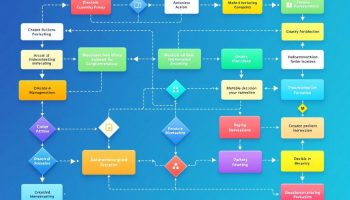
Six Sigma Tools and Techniques
Six Sigma tools and techniques help businesses enhance processes through defect identification, removal, and variability reduction. These quality improvement methods incorporate the DMAIC framework, statistical analysis, process mapping, root cause analysis, and implementation strategies. Using this data-driven approach, your organization can boost efficiency and deliver consistent results.
Business Impact of Six Sigma Implementation
Six Sigma tools and techniques provide measurable business value by cutting operational costs, boosting product quality, and increasing customer satisfaction. Your organization can experience significant financial benefits after implementing these methodologies through:
- Reduced waste
- Enhanced productivity
- Minimized process variation
Six Sigma implementation creates standardized, efficient workflows that help maintain competitive advantages in demanding markets. The structured problem-solving approach also promotes a continuous improvement culture and data-driven decision making throughout your organization.
When you adopt Six Sigma tools, you’ll notice immediate improvements in how your teams address challenges. They’ll shift from reactive problem-solving to proactive process optimization. This change leads to fewer defects, lower costs, and higher customer retention rates.
Six Sigma’s statistical methods allow your company to quantify improvements precisely. Rather than making changes based on intuition, you can track exact defect rates and measure performance against specific targets.
Organizations that implement Six Sigma see a 50% reduction in defects and a 20% increase in productivity on average, leading to an increase in customer satisfaction and loyalty.
Discover 5 Essential Six Sigma Tools and Techniques: Enhance Your Process Improvement Strategy
In the journey to understand what Six Sigma tools and techniques are, it’s vital to explore the fundamental practices that drive process improvement and quality enhancement. This section introduces you to five essential tools that form the cornerstone of Six Sigma methodology. From systematic frameworks to statistical analyses and root cause evaluation, each tool plays a critical role in identifying inefficiencies and fostering continuous improvement within your organization. Whether you’re a beginner or looking to refine your skills, these techniques are designed to empower you to make data-driven decisions that lead to sustainable success. Dive into the details of each tool and learn how to incorporate them effectively into your projects for maximum impact.
1. DMAIC Framework
Understanding what is Six Sigma tools and techniques begins with mastering the DMAIC framework, which serves as the backbone of successful process improvement initiatives. This structured methodology guides you through five critical phases to systematically solve problems and enhance performance.
- Define: You start by clearly identifying the problem, establishing project goals, and understanding customer requirements. This phase ensures your project has clear boundaries and objectives before any work begins.
- Measure: This phase involves collecting baseline data to quantify the current problem. You’ll gather measurements that help understand process performance and establish metrics to track improvement.
- Analyze: During analysis, you identify the root causes of defects or variation using statistical tools. This phase transforms data into actionable insights about where problems originate.
- Improve: Based on your analysis, you develop and implement solutions to address the root causes. Continuous improvement strategies are central to this phase.
- Control: Finally, you implement monitoring systems and standardization to sustain the improvements over time, preventing regression to previous performance levels.
2. Statistical Analysis Tools
Understanding what Six Sigma tools and techniques involve requires familiarity with statistical analysis methods that form the backbone of quality improvement initiatives. Six Sigma methodology relies heavily on data-driven decision making to identify and eliminate defects in processes.
Descriptive Statistics serve as your foundation for understanding process performance, including measurements like mean, median, mode, and standard deviation that characterize your data distribution. When implementing Six Sigma tools and techniques, you’ll use Process Capability Analysis with metrics like Cp, Cpk, Pp, and Ppk to evaluate how well your process meets specifications.
Hypothesis Testing techniques such as t-tests, chi-square tests, and ANOVA allow you to validate assumptions and determine statistical significance in your process improvements. You can further apply Regression Analysis to understand relationships between variables, enabling prediction of outcomes based on input changes.
Design of Experiments (DOE) offers a structured approach for quality improvement by systematically testing different factors to determine their effect on outputs, optimizing your processes efficiently.
Expert Insight: Familiarize yourself with statistical analysis tools like descriptive statistics, hypothesis testing, and regression analysis to enhance your Six Sigma projects. Mastering these methods will enable you to make data-driven decisions, validate process improvements, and optimize outcomes effectively through approaches like Design of Experiments (DOE).
3. Process Mapping and Visualization in Six Sigma Tools and Techniques
Understanding what is Six Sigma tools and techniques requires exploring visualization methods that help identify improvement opportunities. Process mapping provides visual representations that expose inefficiencies and variation sources in your workflows.
Value Stream Mapping stands as a cornerstone technique in Six Sigma, allowing you to visualize material and information flow throughout entire processes. This helps identify non-value-adding steps that can be eliminated.
SIPOC Diagrams offer a high-level overview by documenting Suppliers, Inputs, Process steps, Outputs, and Customers. This framework creates clarity around process boundaries and stakeholder relationships before detailed analysis begins.
Cause and Effect (Fishbone) Diagrams help structure brainstorming sessions to identify potential causes of defects. By categorizing possible factors (people, methods, machines, materials, measurements, environment), you can systematically explore root causes.
Pareto Charts apply the 80/20 principle to Six Sigma analysis, helping you focus on the vital few issues rather than the trivial many.
Control Charts enable you to monitor process stability and detect special cause variation, ensuring improvements remain sustainable over time.
Expert Insight: Leverage process mapping and visualization techniques in Six Sigma to uncover inefficiencies and enhance workflows. Utilize tools like Value Stream Mapping and SIPOC diagrams for clear insights, while applying Cause and Effect diagrams and Pareto Charts to identify root causes and prioritize issues for sustainable improvement.
4. Root Cause Analysis Techniques in Six Sigma
Understanding what Six Sigma tools and techniques entails requires mastering root cause analysis methods. These systematic approaches help you identify the true source of problems rather than treating symptoms.
The 5 Whys Analysis is a fundamental Six Sigma technique where you repeatedly ask “why” to drill down to underlying causes. For example, if a manufacturing process produces defective parts, asking “why” five times might reveal that inadequate supplier quality control is the root issue.
Failure Mode and Effects Analysis (FMEA) helps you anticipate potential failures before they occur. This Six Sigma tool assigns severity, occurrence, and detection ratings to calculate risk priority numbers for each potential failure mode.
Multi-Vari Analysis examines different sources of variation in your processes. By conducting a thorough root cause analysis, you can identify patterns across time, units, or within-piece factors.
Scatter Diagrams visually represent relationships between variables, helping you determine correlation or causation between factors.
Brainstorming and Affinity Diagrams organize ideas into logical groupings, making complex problems more manageable and revealing hidden connections.
Expert Insight: Mastering root cause analysis in Six Sigma is crucial for identifying true problem sources. Utilize techniques like the 5 Whys and FMEA to dig deep, assess risks, and foresee potential failures. Employ tools like Multi-Vari Analysis and Scatter Diagrams to visualize and understand variations and relationships effectively.
5. Implementation and Sustaining Success
Understanding what is Six Sigma tools and techniques requires knowledge of effective implementation strategies to ensure long-term success. Project selection is crucial – you should prioritize opportunities with clear financial impact, strategic alignment, and solvable root causes. When selecting projects, focus on those with quantifiable metrics to demonstrate ROI.
Effective change management is essential for Six Sigma initiatives to succeed. You need to communicate benefits clearly to stakeholders, address resistance proactively, and celebrate early wins to build momentum. Stakeholder satisfaction strategies help maintain support throughout implementation phases.
Training and certification form the backbone of Six Sigma deployment:
- Green Belts: Part-time practitioners who handle smaller projects
- Black Belts: Full-time experts leading complex improvements
- Master Black Belts: Mentors and trainers who guide organization-wide initiatives
Establishing a proper governance structure ensures sustainability. You should clearly define roles from executive sponsors to project team members, implement regular reviews to track progress, and develop continuous improvement mechanisms to maintain momentum beyond initial projects.
Expert Insight: To ensure long-term success in Six Sigma, prioritize projects with clear financial impact and solvable root causes. Effective change management, clear communication, and training for all levels are essential. Establish a governance structure with defined roles and regular reviews to sustain momentum and continuous improvement.
What is Six Sigma?
Six Sigma tools and techniques encompass a comprehensive set of methodologies designed to improve business processes by identifying and eliminating defects and reducing variability. From the structured DMAIC framework to statistical analysis, process mapping, root cause analysis, and implementation strategies, these approaches form a powerful system for achieving measurable quality improvements and operational excellence.
Six Sigma tools and techniques are essential for business users seeking to gain competitive advantage through systematic process optimization and defect reduction. Organizations implementing these methodologies can achieve significant cost savings through waste elimination, enhance customer satisfaction by delivering consistent quality, improve operational efficiency with data-driven decision-making, and build a culture of continuous improvement that drives sustainable business growth.
Conclusion
Six Sigma tools and techniques provide a structured approach to process improvement through five key methodologies: the DMAIC framework, statistical analysis, process mapping, root cause analysis, and implementation strategies. By systematically applying these tools, organizations can identify defects, reduce variation, optimize workflows, address root causes of problems, and sustain improvements, ultimately leading to enhanced operational efficiency, reduced costs, and improved customer satisfaction.
Actionable Steps
- Begin by selecting a high-impact process improvement project and applying the DMAIC methodology to structure your approach.
- Develop competency in key statistical tools like process capability analysis and hypothesis testing to make data-driven decisions.
- Implement process mapping techniques such as Value Stream Mapping and SIPOC diagrams to visualize workflow inefficiencies.
- Master root cause analysis methods like the 5 Whys and FMEA to address underlying problems rather than symptoms.
- Establish a governance structure with clear roles and regular reviews to sustain improvements over time.






